
views
Organizing the Summary Paragraph

Take notes on the original text. Start by reading and reviewing the original text. Mark up the original text, noting any keywords and important phrases or points. Highlight or underline any sentences that feel important to you. Note the topic sentence in the original text as well as the main idea or theme in the text. The topic sentence will contain the main topic or idea in the text. If you are working with a long original text, create a brief outline for each paragraph in the margin of the text. Include any keywords, phrases, or points in the summary. You can then use these notes in your summary paragraph. Focus especially on the first and last 2 couple of sentences or paragraphs in the text, along with some of the keywords. These can help you figure out the main idea.
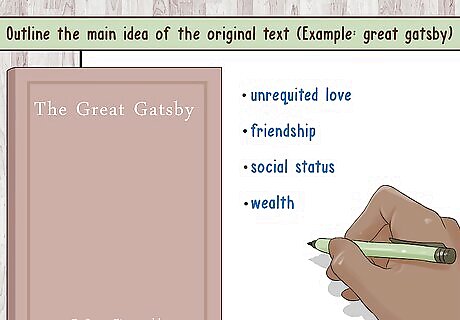
Outline the main idea of the original text. Create a one to two sentence outline of the main idea or ideas of the original text. Keep the outline short and to the point. Ask yourself, “What is the author trying to say in this text? What is the main idea or theme in the text?” For example, if you were using The Great Gatsby by F. Scott Fitzgerald as the original text, you may list several themes or ideas such as “friendship,” “social status,” “wealth,” and “unrequited love.”
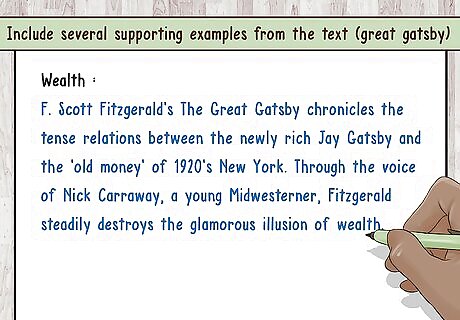
Include several supporting examples from the text. Once you have the main idea down, identify one to three examples from the original text that support the main idea. These could be quotes from the text or scenes in the text. You could also choose a pivotal moment or passage in the text as a supporting example. List these supporting examples and briefly summarize them by noting what happens in each example. You can then refer to these examples in your summary paragraph.
Creating a Strong Opening Line

Include the author, title and publication date. The first line of the summary paragraph should state the author, the title, and the publication date of the original text. You should also note what type of text it is, such as a novel, a short story, or an article. This will present the reader with the most basic information about the original text right away. For example, you may begin with, “In the novel The Great Gatsby (1925), F. Scott Fitzgerald…”. If you are writing a summary of an article, you may begin with, “According to her article, “What is intersexuality?” Nancy Kerr (2001)...”
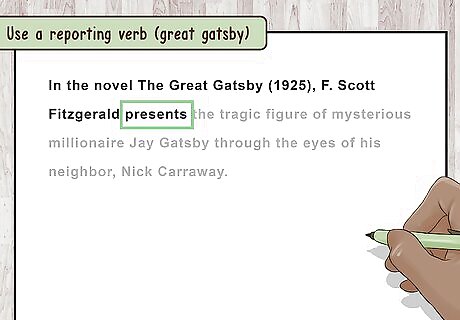
Use a reporting verb. The first line of the summary paragraph should include a strong reporting verb, such as “argue,” “claim,” “contend,” “maintain,” or “insist.” You can also use verbs like “explain,” “discuss,” “illustrate,” “present,” and “state.” This will make the introduction of the summary paragraph clear and concise. For example, you may write, “In the novel The Great Gatsby (1925), F. Scott Fitzgerald presents...” For an article, you may write, “According to her article, “What is intersexuality?” Nancy Kerr (2001) claims...”
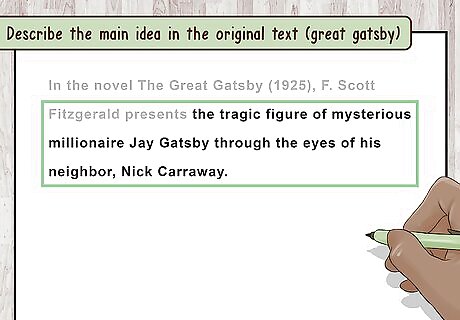
Describe the main idea in the original text. Finish the opening line by including the main theme or idea in the text. You can then include supporting points in the rest of the summary that relate back to this main theme or idea. For example, you may write, “In the novel The Great Gatsby (1925), F. Scott Fitzgerald presents the tragic figure of mysterious millionaire Jay Gatsby through the eyes of his neighbor, Nick Carraway.” For an article, you may write, “According to her article, “What is intersexuality?” Nancy Kerr (2001) claims that discussions of sexuality in academic circles ignores the growing public interest in intersexuality.”
Writing a Good Summary Paragraph
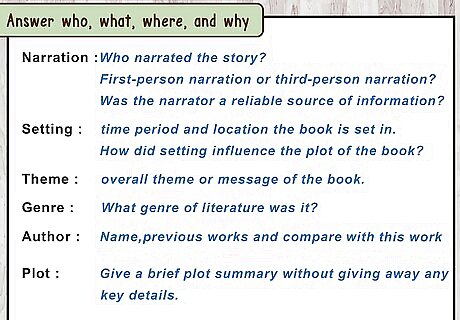
Answer who, what, where, and why. Consider who is being addressed or discussed in the original text. Think about what is being addressed or discussed. Mention where the text is set, if relevant. Finally, determine why the author is discussing or addressing the subject matter in the original text. For example, if you are writing about The Great Gatsby, you should address the two main characters in the novel (Jay Gatsby and his neighbor/the narrator Nick Carraway). You should also focus on what occurs, briefly, in the novel, where the novel takes place, and why Fitzgerald explores the lives of these two characters.

Have one to three sentences of supporting evidence. Aim to have one to three supporting points at the most, as you do not want to make the summary paragraph too long. Use events from the text as well as quotes or points in the text to support your opening line. For example, if you are discussing an article, you may use the author’s key arguments in the article as supporting points. If you are discussing a novel or short story, you may use the key events in the story as supporting points.
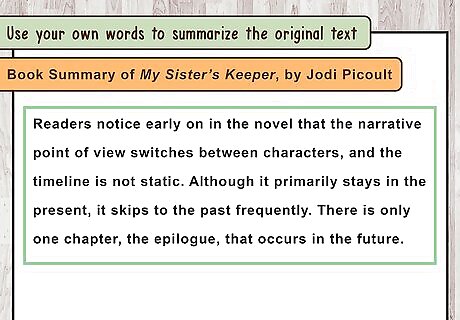
Use your own words to summarize the original text. Do not copy or paraphrase the original text. Use your own words in the summary. Avoid using the same language or word choice as the original text, unless you are quoting it directly. Keep in mind a summary paragraph should simply state the essential information in the original text. You do not need to present an opinion or argument about the text in the summary paragraph. This can be done in a separate paragraph or section in your paper. Try to use varied, interesting verbs in your summary. If you use the same ones over and over, your reader will get bored as they read.

Keep the summary short and to the point. A summary paragraph should be no longer than six to eight sentences. Once you finish a draft of the summary paragraph, read it over and revise it so it is short and to the point. Remove any sentences or phrases that seem redundant or repetitive. You may also show the summary paragraph to a writing instructor or a friend to get feedback on it. Ask the person to make sure the summary paragraph includes the essential information about the text in a concise, clear way.




















Comments
0 comment